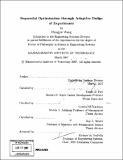| dc.contributor.advisor | Daniel D. Frey, Gordon M. Kaufman and Roy E. Welsch. | en_US |
| dc.contributor.author | Wang, Hungjen, 1971- | en_US |
| dc.contributor.other | Massachusetts Institute of Technology. Engineering Systems Division. | en_US |
| dc.date.accessioned | 2007-10-22T17:37:05Z | |
| dc.date.available | 2007-10-22T17:37:05Z | |
| dc.date.copyright | 2007 | en_US |
| dc.date.issued | 2007 | en_US |
| dc.identifier.uri | http://hdl.handle.net/1721.1/39332 | |
| dc.description | Thesis (Ph. D.)--Massachusetts Institute of Technology, Engineering Systems Division, 2007. | en_US |
| dc.description | Includes bibliographical references (p. 111-118). | en_US |
| dc.description.abstract | This thesis considers the problem of achieving better system performance through adaptive experiments. For the case of discrete design space, I propose an adaptive One-Factor-at-A-Time (OFAT) experimental design, study its properties and compare its performance to saturated fractional factorial designs. The rationale for adopting the adaptive OFAT design scheme become clear if it is imbedded in a Bayesian framework: it becomes clear that OFAT is an efficient response to step by step accrual of sample information. The Bayesian predictive distribution for the outcome by implementing OFAT and the corresponding principal moments when a natural conjugate prior is assigned to parameters that are not known with certainty are also derived. For the case of compact design space, I expand the treatment of OFAT by the removal of two restrictions imposed on the discrete design space. The first is that the selection of input level at each iteration depends only on observed best response and does not depend on other prior information. In most real cases, domain experts possess knowledge about the process being modeled that, ideally, should be treated as sample information in its own right-and not simply ignored. | en_US |
| dc.description.abstract | (cont.) Treating the design problem Bayesianly provides a logical scheme for incorporation of expert information. The second removed restriction is that the model is restricted to be linear with pair-wise interactions - implying that the model considers a relatively small design space. I extend the Bayesian analysis to the case of generalized normal linear regression model within the compact design space. With the concepts of c-optimum experimental design and Bayesian estimations, I propose an algorithm for the purpose of achieving optimum through a sequence of experiments. I prove that the proposed algorithm would generate a consistent Bayesian estimator in its limiting behavior. Moreover, I also derive the expected step-wise improvement achieved by this algorithm for the analysis of its intermediate behavior, a critical criterion for determining whether to continue the experiments. | en_US |
| dc.description.statementofresponsibility | by Hungjen Wang. | en_US |
| dc.format.extent | 118 p. | en_US |
| dc.language.iso | eng | en_US |
| dc.publisher | Massachusetts Institute of Technology | en_US |
| dc.rights | M.I.T. theses are protected by copyright. They may be viewed from this source for any purpose, but reproduction or distribution in any format is prohibited without written permission. See provided URL for inquiries about permission. | en_US |
| dc.rights.uri | http://dspace.mit.edu/handle/1721.1/7582 | |
| dc.subject | Engineering Systems Division. | en_US |
| dc.title | Sequential optimization through adaptive design of experiments | en_US |
| dc.type | Thesis | en_US |
| dc.description.degree | Ph.D. | en_US |
| dc.contributor.department | Massachusetts Institute of Technology. Engineering Systems Division | |
| dc.identifier.oclc | 173516789 | en_US |
